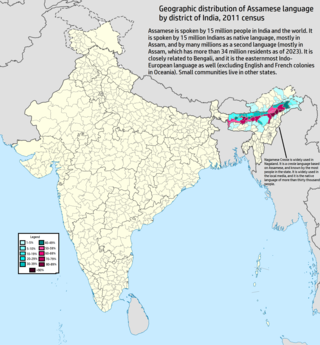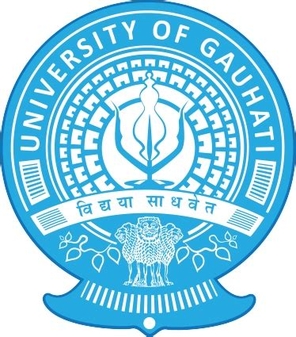
Assamese, also Asamiya ( অসমীয়া), is an Indo-Aryan language spoken mainly in the north-eastern Indian state of Assam, where it is an official language, and it serves as a lingua franca of the wider region. The easternmost Indo-Iranian language, it has over 15 million speakers according to Ethnologue.

Bihu is a set of three important cultural festivals unique to the Indian state of Assam – 'Rongali' or 'Bohag Bihu' observed in April, 'Kongali' or 'Kati Bihu' observed in October or November, and 'Bhogali' or 'Magh Bihu' observed in January. The festivals present an admixture of Tibeto-Burman, Austroasiatic and Indo-Aryan traditions entwined so intricately that it is impossible to separate them—festivals which are uniquely Assamese to which all communities of Assam had contributed elements. The Rongali Bihu is the most important of the three, celebrating spring festival. The Bhogali Bihu or the Magh Bihu is a harvest festival, with community feasts. The Kongali Bihu or the Kati Bihu is the sombre, thrifty one reflecting a season of short supplies and is an animistic festival.

Makar(a) Sankranti, also referred to as Uttarayana, Makar, or simply Sankranti, is a Hindu observance and a festival. Usually falling on the date of January 14 annually, this occasion marks the transition of the sun from the zodiac of Sagittarius (dhanu) to Capricorn (makara). Since the sun has made this transition which vaguely coincides with moving from south to north, the festival is dedicated to the solar deity, Surya, and is observed to mark a new beginning. Many native multi-day festivals are organised on this occasion all over India.

The Kamakhya Temple at Nilachal hills in Guwahati, Assam is one of the oldest and most revered centres of Tantric practices, dedicated to the goddess Kamakhya. The temple is the center of the Kulachara Tantra Marga and the site of the Ambubachi Mela, an annual festival that celebrates the menstruation of the goddess. Structurally, the temple is dated to the 8th-9th century with many subsequent rebuildings—and the final hybrid architecture defines a local style called Nilachal. It is also one among the oldest 4 of the 51 pithas in the Shakta tradition. An obscure place of worship for much of history it became an important pilgrimage destination, especially for those from Bengal, in the 19th century during colonial rule.

Kamakhya, a mother goddess, is a Shakta Tantric deity; considered to be the embodiment of Kama (desire), she is regarded as the goddess of desire. Her abode–Kamakhya Temple is located in the Kamarupa region of Assam, India. Originally a Kirata goddess, Kamakhya remained outside Brahmanical influence until at least 7th century CE. Residing on Nilachal hills across the banks of the Brahmaputra river, west of Guwahati in the 10th/11th century Temple rebuilt in 1565 CE, she is worshiped in a non-iconic and un-anthropomorphic form of stone shaped like yoni fed by a perennial stream. The temple is primary amongst the 51 Shakti Pithas, and is one of the most important Shakta temples.

Kamarupa, an early state during the Classical period on the Indian subcontinent, was the first historical kingdom of Assam.

Assamese literature is the entire corpus of poetry, novels, short stories, plays, documents and other writings in the Assamese language. It also includes the literary works in the older forms of the language during its evolution to the contemporary form and its cultural heritage and tradition. The literary heritage of the Assamese language can be traced back to the c. 9–10th century in the Charyapada, where the earliest elements of the language can be discerned.

Gauhati University also known as GU, is a collegiate public state university located in Guwahati, Assam, India. It was established on 26 January 1948 under the provisions of an Act enacted by the Assam Legislative Assembly and is the oldest university in Northeast India.
Though the precise Etymology of Assam, a state in India is unclear—there is general agreement that it is related to the Ahom people. Whatever the source of the English name, Assam is itself an anglicization.

Bohag Bihu or Rongali Bihu also called Xaat Bihu is a traditional ethnic festival celebrated in the Northeastern Indian state of Assam and other parts of Northeastern India by the indigenous ethnic groups of Assam, and marks the beginning of the Assamese New Year. The festival is of mostly aboriginal origin comprising Tibeto-Burman and Tai elements. It usually falls in the 2nd week of April, historically signifying the time of harvest. Every year it falls on the 14th day of April. The holiday unites the different native communities of Assam regardless of their backgrounds and promotes the celebration of ethnic diversity.

Magh Bihu (also called Bhogali Bihu or Maghar Domahi is a harvest festival celebrated in Assam, North-East India, which marks the end of harvesting season in the month of Magh. A bonfire is lit for the ceremonial conclusion and prayer to the God of Fire. The festival is developed by the Tibeto-Burman and Indo-aryan cultures and festivals Magan of Kachari.

The Hajong people are an ethnic group from Northeast India and northern parts of Bangladesh. The majority of the Hajongs are settled in India and are predominantly rice-farmers. They are said to have brought wet-field cultivation to Garo Hills, where the Garo people used slash and burn method of agriculture. Hajong have the status of a Scheduled Tribe in India and they are the fourth largest tribal ethnicity in the Indian state of Meghalaya.

Kamrupi dialects are a group of regional dialects of Assamese, spoken in the Kamrup region. It formerly enjoyed prestige status. It is one of two western dialect groups of the Assamese language, the other being Goalpariya. Kamrupi is heterogeneous with three subdialects— Barpetia dialect, Nalbariya dialect and Palasbaria dialect.

Kamrup is the modern region situated between two rivers, the Manas and the Barnadi in Western Assam, with the same territorial extent as the Colonial and post-Colonial "Undivided Kamrup district". It was the capital region of two of the three dynasties of Kamarupa and Guwahati, the current political center of Assam, is situated here. It is characterized by its cultural artifacts.
Kamrupi culture refers to the cultural norms of people of colonial Kamrup district.

Kamapitha is one of the four Kamarupa Pithas, the geographical divisions of ancient Kamarupa. Dineshchandra Sircar points out that these divisions are not found in the Kamarupa inscriptions and that they might be fabrications from late medieval sources, such as 16th-century work Yogini Tantra gives the boundaries of Kamapitha and other three pithas, the same work which gives boundaries of ancient Kamrup kingdom as well. The eastern border of Kamarupa was the temple of the goddess Tamreshvari near present-day Sadiya
Amati, also known as Ambuvachi, is a ritual followed in Kamrup and Goalpara regions in Western Assam. It is an ancient fertility cult and also incorporated into the mother goddess cult as Kamakhya as its centre.
The Kamrupi people are a linguistic group that speak the Kamrupi dialects of Assamese and are found in the colonial Kamrup district region of Assam, India.
Mohoho is a folk festival celebrated in the lower Assam region of India, especially in the districts of Kamrup, Goalara, Barpeta, Nalbari, and Darrang. The festival is held in the month of Aghun (October–November) during the full moon night.
Bhatheli, also known as Paowra Tola, is a Hindu festival mainly celebrated in North Kamrup, Assam. The festival is held in the month of Vaisakha. In northern Kamrup, it's referred to as "Bhatheli", while in southern Kamrup, it goes by the names "Sori" or "Suanri". In Goalpara, it's known as Sori, and in Darrang, it's called "Deul". Where in the Bajali area of north Kamrup a bamboo is kept against a Banyan tree called "Madan Mohan Gosain", a name of Krishna.













